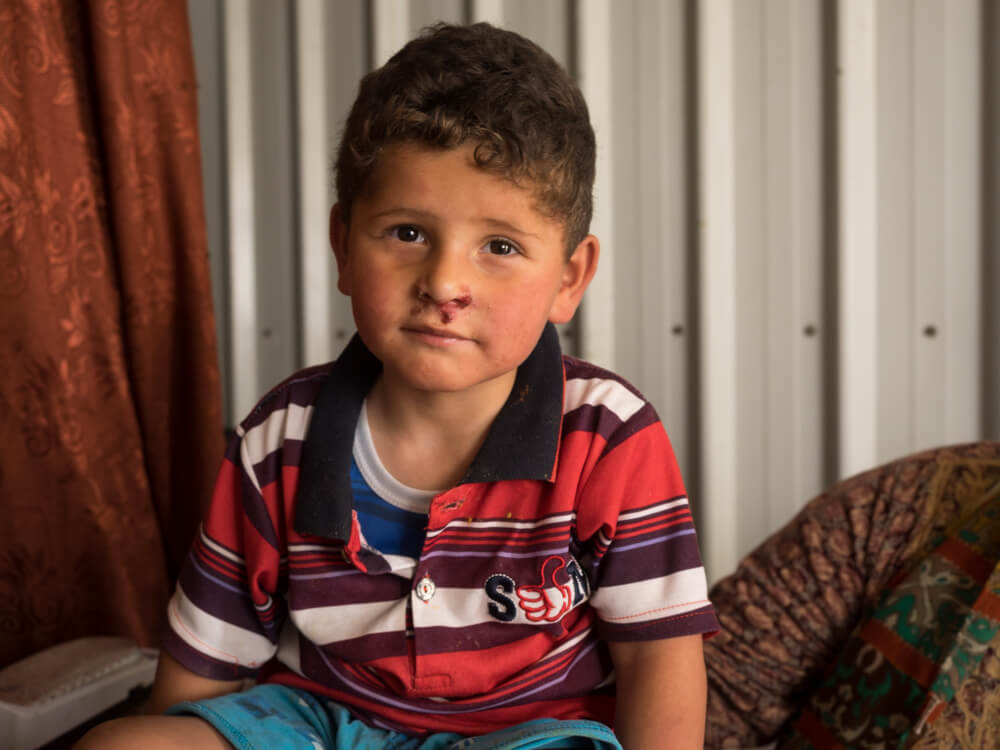Two-year-old Ahmad Najjar scooted on his rear end across the dirt in front of the shipping container he and his family live in the Gaza farming village of Khuza’a. Unable to walk because of a genetic condition and lacking a wheelchair, Ahmad resorts to dragging himself by his hands. His grandmother, who also can not walk and is blind, sat and wailed inside the container in sweltering heat. “I’m so hot! God help me,” she moaned while rocking back and forth. The Najjar family’s stately home in Khuza’a was one of 100,000 homes damaged or destroyed during Israel’s war on Gaza in 2014 that killed more than 2200 Palestinians, most of whom were civilians. Eight months after the final ceasefire reconstruction in Gaza has not begun, and the Najjar family is is forced to live in a donated shipping container just across the street from the four-meter-high mound of rubble that used to be their home.
Ahmad’s father Youssef Najjar, 46, mostly blind and afflicted with nerve damage, stood over his mother and broke into tears. “In this caravan, our life is all about suffering,” he sighed.
Seventy-four other families, mostly from the larger Najjar family live in the caravan as well. Makeshift pathways have been cleared through the rubble, and the biggest chunks were piled up to form a massive hill where a tent sits on top and overlooks the grey moonscape of destruction. In the distance one can see Khuza’a’s farmland and Israeli towns across the border, as well as intermittent Israeli pillboxes equipped with remote-control machine guns aiming into Khuza’a.

With their lives hanging by threads, the families living in the caravan are among the most vulnerable Palestinians in the besieged Gaza Strip. Every day is a crisis, and each season brings new difficulties which the residents are ill-equipped to confront.
I first met the Najjar family during a severe winter storm in January. The day before my visit, their container was flooded with rainwater and sewage nearly a meter high. Unable to walk, Ahmad was trapped inside and nearly drowned before being rescued. The day after my visit, heavy rains again flooded the caravans.
Throughout the winter, the uninsulated containers were iceboxes. In freezing temperatures with heavy rains and hail, families had no choice than to build fires in the containers in order to stay warm. “At night, I can’t get warm with eight blankets,” Youssef Najjar told me in January.
Now as summer approaches, the Mediterranean heat is turning the poorly ventilated containers into sweltering boxes. The caravans are unsanitary and cramped — sometimes with a dozen people per container — and makeshift additions built from wood and scrap metal have been attached. “We used to live in a big house and we suffered from the heat,” Youssef Najjar said. “But that doesn’t compare to what we live through now.”
Throughout the winter, promises of reconstruction kept a glimmer of hope among the population of the caravan. After donors gathered in Cairo and $5.4 billion was promised to rebuild Gaza, only a fraction has been allowed in as Israel, the Egyptian coup regime, and Palestinian Authority President Mahmoud Abbas have colluded to prevent delivery of construction materials. Any hope has long since evaporated and the bitter reality of the siege is now undeniable. “Rebuilding my house is a lie. I heard about reconstruction in the media. It’s all bullshit,” Najjar remarked.
Worse yet, rumors are afloat that the caravan may be evicted by the owner of the land, leaving the families with absolutely nowhere to go. “As much as I can talk about it, it’s not enough — I can’t put it into words,” Najjar told me.




No words !!!
It’s these reminders of the minute- by- minute torment that the Palestinians of Gaza are forced to endure that are really crucial to profile and tell. So thank you, Dan, for your devotion to bring the world the awful truth and reality, and for your tireless support of the otherwise voiceless, nameless, faceless, and forgotten Palestinians.
I am sure that there are too many people all over that think that this suffering family should just be grateful that they survived last summer’s massacre, and be happy that the IOF is not trying to actively kill them right now. The GoI is trying, anyway~ with this slower and very gruesome torture.
This makes me feel …. sick! Is this Dalia’s family – they have the same name? Dan, can you not get this on something mainstream? What sort of a world are we living in?
Zionism has much to answer for and the day of reckoning is coming.Maybe not the day after tomorrow , but it is coming.
I would not want to be a zionist apologist when that day arrives.Of course many of them will conveniently become opponents who spoke out bravely against it —-always.
Somebody on another thread mentioned the White South Africans who magically changed their colours when matters went against them.
100% of the blame on Israel?
0% of the blame on Arab priorities & choices?
The misery is real. Its use is cynical.